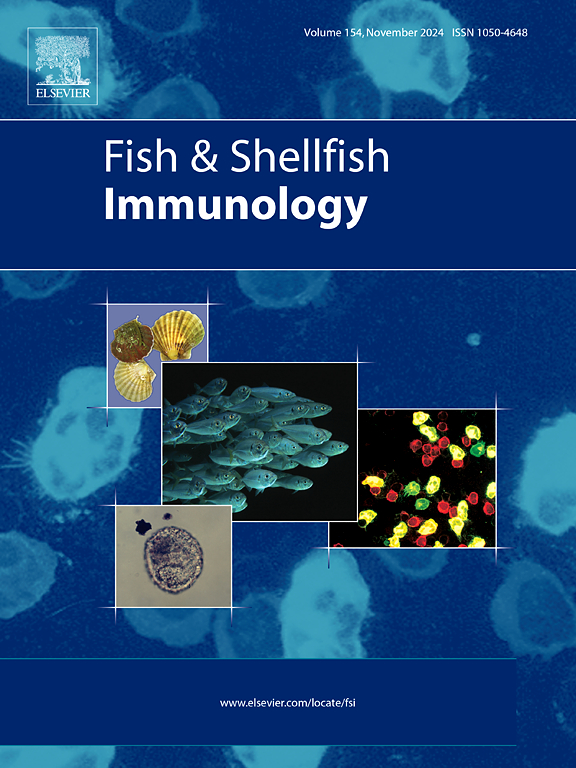稻草生物炭和微囊藻毒素lr对雄性斑马鱼脾脏组织病理学损伤、炎症和先天免疫反应的联合影响
IF 4.1
2区 农林科学
Q1 FISHERIES
引用次数: 0
摘要
微囊藻毒素lr (MC-LR)是一种由蓝藻繁殖产生的毒素,对水生动物和人类构成重大威胁。生物炭具有较高的吸附能力,被越来越多地用于去除水生环境中的有害污染物。在本研究中,我们进行了一项全因子实验,研究雄性斑马鱼(Danio rerio)暴露于环境相关水平的MC-LR (0,1,5,25 μg/L)和水稻茎源BC (0,100 μg/L) 30 d的潜在免疫毒性。研究结果表明,亚慢性MC-LR暴露会引起浓度依赖性的脾脏组织病理学损伤,其特征是黑素巨噬细胞中心增强、线粒体水肿和空泡化。而BC的存在减轻了联合组的炎症反应和线粒体损伤。此外,与单独暴露于25 μg/L MC-LR组相比,相应的共暴露组白细胞介素1β (il - 1β)、肿瘤坏死因子α (TNFα)和白细胞介素6 (il - 6)水平降低,炎症和免疫相关基因(tlr4a、myd88、p38a、TNFα)显著下调,证实BC可以减轻MC-LR诱导的炎症反应。同时,与单独暴露于MC-LR组相比,MC-LR-co-BC组补体C3 (C3)含量显著增加,脾脏c3b表达水平较高,表明BC减轻了MC-LR诱导的先天免疫抑制。我们的研究结果还表明,BC可以降低MC-LR在水和脾脏中的含量,从而通过MyD88依赖性toll样受体(TLR/MyD88)信号通路减轻MC-LR诱导的炎症和先天免疫抑制。我们的研究结果强调了BC减轻MC-LR对水华污染水体中水生生物的有害影响的潜力。本文章由计算机程序翻译,如有差异,请以英文原文为准。

Joint effects of rice straw-derived biochar and microcystin-LR on splenic histopathological injuries, inflammation, and innate immune responses in male zebrafish
Microcystin-LR (MC-LR), a toxin produced by cyanobacterial blooms, poses a significant threat to aquatic animals and humans. Biochar (BC), known for its high adsorption capacity, is increasingly being utilized to remove hazardous pollutants from aquatic environment. In the present study, we conducted a full factorial experiment to investigate the potential immunotoxicity in male zebrafish (Danio rerio) exposed to environmentally relevant levels of MC-LR (0, 1, 5, 25 μg/L) and rice straw-derived BC (0, 100 μg/L) for 30 d. The findings revealed that subchronic MC-LR exposure caused concentration-dependent splenic histopathological injuries, characterized by an augmentation of melano-macrophage centers, edematous mitochondria, and vacuolation. While the presence of BC mitigated the inflammatory response and mitochondrial damage in the combined groups. Furthermore, in contrast to the group solely exposed to 25 μg/L MC-LR, decreased levels of interleukin 1β (IL1β), tumor necrosis factor α (TNFα), and interleukin 6 (IL6) as well as significant downregulation of inflammation and immune-related genes (tlr4a, myd88, p38a, tnfα) were noticed in the corresponding co-exposure group, which confirmed that BC can reduce MC-LR-induced inflammatory response. Concurrently, a significant increase in complement C3 (C3) content, along with higher splenic c3b expression levels, was observed in the MC-LR-co-BC group in relative to the group exposed solely to MC-LR, suggesting that BC alleviated MC-LR-induced innate immune inhibition. Our results also demonstrated that BC can decrease MC-LR contents in both water and spleen, thereby alleviating MC-LR-induced inflammation and innate immune inhibition via the MyD88-dependent toll-like receptor (TLR/MyD88) signaling pathway in male zebrafish. Our results underscore the potential of BC to mitigate the deleterious impacts of MC-LR on aquatic organisms in blooms-contaminated water.
求助全文
通过发布文献求助,成功后即可免费获取论文全文。
去求助
来源期刊

Fish & shellfish immunology
农林科学-海洋与淡水生物学
CiteScore
7.50
自引率
19.10%
发文量
750
审稿时长
68 days
期刊介绍:
Fish and Shellfish Immunology rapidly publishes high-quality, peer-refereed contributions in the expanding fields of fish and shellfish immunology. It presents studies on the basic mechanisms of both the specific and non-specific defense systems, the cells, tissues, and humoral factors involved, their dependence on environmental and intrinsic factors, response to pathogens, response to vaccination, and applied studies on the development of specific vaccines for use in the aquaculture industry.
 求助内容:
求助内容: 应助结果提醒方式:
应助结果提醒方式:


